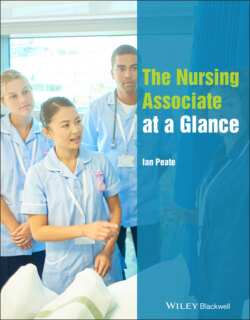Читать книгу The Nursing Associate at a Glance - Ian Peate - Страница 16
Оглавление4 Non‐discriminatory behaviour
At the point of registration, the Nursing Associate will be able to: demonstrate an understanding of, and the ability to, challenge or report discriminatory behaviour.
Figure 4.1 The nine protected characteristics.
Table 4.1 Types of discrimination.
| Type of discrimination | Discussion |
|---|---|
| Direct discrimination | When a person with a protected characteristic is treated less favourably than others. |
| Indirect discrimination | If there is a rule, policy or protocol that puts a person at a disadvantage as compared to others, it may be considered indirect discrimination. |
| Discrimination by association | If a person is treated unfairly because someone you know or are caring for has a protected characteristic, this may be construed as discrimination by association. For example, you are refused service in a restaurant because the person you are with has a disability. |
| Discrimination by perception | Receiving unfair treatment because someone thinks the person belongs to a group with protected characteristics may be discrimination by perception. For example, a person with a mental health problem is refused a lease for a flat by an estate agent because they assume people with mental health issues behave in a certain way. |
| Harassment | This comprises unwanted behaviour making another person feel offended, humiliated or intimidated. Unwanted behaviour could include physical gestures, abuse, jokes, spoken or written words or offensive emails and expressions. |
| Victimisation | When a person is treated badly or subjected to disadvantage because they have complained about discrimination or they have supported another victim of discrimination, this could be considered victimisation. |
Top Tip
Never ignore or excuse discriminatory behaviour any more than you would ignore someone if they were in pain.
Protected characteristics
In October 2010 the Equality Act came into force, providing a single legal framework with clear, streamlined law to help tackle disadvantage and discrimination in a more effective way. The Equality Act 2010 has identified nine protected characteristics (see Figure 4.1).
Because every person has at least some of these characteristics such as age, race or gender, the Act protects every person from being discriminated against. If a person is treated unfavourably because someone thinks that person belongs to a particular group of people with protected characteristics, this is unlawful discrimination.
Discrimination happens when people are treated differently and negatively because assumptions are made about them or a group to which they belong or appear to belong to. Some examples can include:
Labelling – giving a ‘label’ to a group of people because of characteristics, e.g. an individual being labelled as ‘Asian’ based solely on the colour of their skin
Stereotyping – assuming traits and characteristics of a group of people e.g. all individuals with autism are highly intelligent
Prejudice – not liking somebody because of the group they belong to, e.g. racism, sexism, homophobia and so on.
Discriminatory behaviour
Discrimination means treating another person unfairly because of who they are or because they have certain characteristics. If a person has been treated differently from other people only because of who they are or because they possess certain characteristics, then they may have been discriminated against, and discriminatory behaviour is illegal. There are several types of discrimination (see Table 4.1).
Challenging discriminatory behaviour
In order to promote a culture of anti‐discrimination, any and all discrimination should be challenged as soon as possible and in a way that encourages change. Discrimination must never be accepted, excused or dismissed; it should always be challenged to be sure that the discriminating individual understands that their behaviour is unacceptable, whether it was deliberate or unintentional.
A public authority is an organisation that provides public services. NHS hospitals or social services are public sector organisations. Private organisations or charities which carry out public services or functions are also known as public authorities, such as, a private care home that is funded by a local authority. If a person has experienced discrimination by a public authority, there are several things that can be done.
If there is an allegation that unlawful discrimination has taken place, one option might be to try to sort out the problem informally at first, for example, talking to the people who are alleged to have been discriminatory. It is important to keep a note, a record, of any conversations or meetings that have taken place.
Employers will have agreed ways of working, and this will provide guidance about challenging and reporting acts of discrimination. The Nursing Associate in training must seek support from their supervisor, line manager or training organisation/university. Policy and procedure will be in place, and these must be adhered to.
Speaking up if somebody is being discriminatory lets the person know that their behaviour is unacceptable and can offer the opportunity to educate them about why discrimination is unacceptable.
Reporting discrimination to your supervisor, manager or making a complaint regarding the person discriminating means that the report/complaint must be taken seriously, and it has to be investigated according to policies and the law.
The Nursing Associate is required to act as an advocate for the vulnerable, challenging discriminatory attitudes and behaviour concerning their care; at all times, you must treat people fairly and without discrimination, bullying or harassment.
